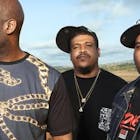Hip-Hop in the late 80s was exploding, with Public Enemy urging Black youth to fight the power and N.W.A. screaming "Fuck the police." DJ Jazzy Jeff and the Fresh Prince and Kid 'n Play were keeping things upbeat on the radio and hip-house was moving folks on the dancefloors. But De La Soul was none of the above.
Regardless of whether you believe "alternative Hip-Hop" is a thing, it's hard to deny De La Soul's 3 Feet High & Rising as a landmark in its development and the first real mainstream success for a quirky, left-field rap act. The Jungle Brothers got there first, but with the radio and chart success of hit single "Me, Myself & I," De La Soul got a broader audience. The album made the trio critical darlings and crossover rap stars. But after two years, 3 Feet High & Rising had become a proverbial albatross around three kids from Amityville's necks.
By 1991, Pos, Trugoy and Maseo had had enough. De La Soul was fucking tired: tired of being branded "Hip-Hop hippies" by the clueless; tired of being challenged by the streets; and tired of being hamstrung by their groundbreaking debut. For all of the success it'd found and all of the accolades it had been received, 3 Feet High was threatening to pigeonhole De La. With it's Day-Glo cover (something the group themselves hated) and references to "The D.A.I.S.Y. Age" (it stands for "Da Inna Sound, Y'all"), 3 Feet High...saddled De La Soul with an image that they were eager to shuck on their sophomore project.
They'd already been pushing back against their early image while touring in support of 3 Feet... Producer Prince Paul helmed that project and was hailed for his visionary work with the group, but he was shocked to hear stories of gunplay while De La Soul was out on the road.
"Random people would come up to me like 'Yo, your boys out on the road - I heard they beat up such-and-such,'" Prince Paul recalled in Mass Appeal's 2016 mini-doc De La Soul Is Not Dead. "I'm like whaaat? Or 'They shot up a car!' I'd hear all these different stories because people knew I worked with them - like 'wow that's crazy.' And I'd ask 'em and they'd be like 'Yeah that's true.'"
“100 percent of the people listening to De La Soul were really attached to the image and not to what we were trying to say," Dave aka Trugoy told Rolling Stone in 1991 just before the release of the group's follow-up to 3 Feet High..., with Pos adding, “We didn’t want to be pinned down to a visual look, and so we thought, ‘This whole daisy thing has to just die.'"








